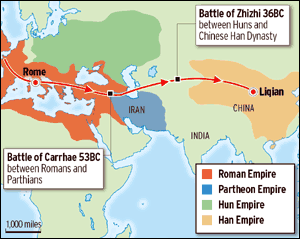
© The Telegraph, UKRome to China map, Roman descendants found in China?
Residents of a remote Chinese village are hoping that DNA tests will prove one of history's most unlikely legends - that they are descended from Roman legionaries lost in antiquity.
Scientists have taken blood samples from 93 people living in and around Liqian, a settlement in north-western China on the fringes of the Gobi desert, more than 200 miles from the nearest city.
They are seeking an explanation for the unusual number of local people with western characteristics - green eyes, big noses, and even blonde hair - mixed with traditional Chinese features.
"I really think we are descended from the Romans," said Song Guorong, 48, who with his wavy hair, six-foot frame and strikingly long, hooked nose stands out from his short, round-faced office colleagues.
"There are the residents with these special features, and then there are also historical records about the existence of these people long ago," he said.